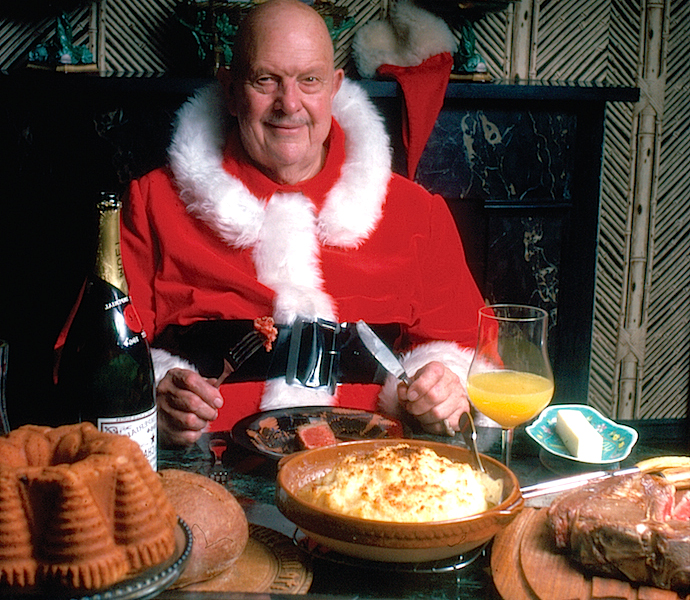
‘Tis the season! The season of James Beard’s favorite foods, that is—the country hams cut into salty slivers, the piping hot oyster stews with plenty of hot buttered toast, the Champagne sipped with a connoisseur’s glee, the caviar he couldn’t get enough of, the homemade pâtés, the plum puddings, the mincemeat, and, yes, even the fruitcakes. Bits and pieces of Beard’s childhood always emerged at their warmest and most expansive in his writings about the Christmas holidays, but another theme also ran through and true—simplicity. For as much as Beard loved life in the larger-than-life lane that corresponded with his physical scale and theatrical impulses, deep down he never lost sight of the fact that less is genuinely more. Simple flavors. Simple recipes. Simple cooking. In these excerpts from Beard on Food and the December 1994 issue of Beard House magazine, the recurring theme is simplicity. Read on for our namesake's tips for holiday gatherings that require less effort and yield greater reward.
--
Why do so many people seem to feel that at Christmas every meal they serve their guests must be a feast? They entertain simply and sensibly all year, but come the festive season they offer too much rich food, far beyond what anyone could possibly want. Sooner or later in the round of entertaining I find myself longing for something simple and good to eat. I’ve found many of my friends feel as I do, so on many Christmases I’ve given the kind of party that everyone can enjoy. It’s easy, its unassuming, it's guaranteed not to upset the delicate balance of anyone’s digestion, and it is a great contrast to the traditional Christmas celebration.
First, I give my guests a well-chilled dry sherry, then I bring on good healthy servings of oyster stew and continue pouring the chilled sherry because sherry and seafood things go well together. Oyster stew is a most reviving, nourishing, and delectable dish. After the oyster stew I put out a big board of various slicing sausages—salami, Polish sausage, whatever I find in the market that looks good—and an assortment of mustards. I also like to have another board of cheeses: Swiss gruyère, a fine cheddar, and maybe a brie. And with the cheeses, I serve thinly sliced rye bread and crackers of some kind and a bowl of fruit. I have plenty of iced beer and a bottle or two of red wine.
This, to my mind, makes the best of all Christmas parties because you haven’t loaded your guests down with Christmas cheer and Christmas richness and lot of cakes and pies and sweet things. It’s novel, it’s a perfect combination of food and drink and each person can take as much or as little as he pleases. —James Beard
James Beard’s Oyster Stew
Makes 4 generous servings
The first important thing is to heat the individual bowls in which you will serve the stew and, when they are quite hot, put a large dab of butter in each one. Keep them warm while you do the cooking, which takes only minutes. Heat to the boiling point 1 pint of cream, 1 pint of milk, and the liquor from 1 1/2 to 2 pints of shucked oysters—although 2 pints is a safer amount: it will give you quite a bit of liquor if you buy the oysters in bulk. Season to taste with salt and freshly ground black pepper, and add a good dash of Tabasco and 1/2 to 1 teaspoon Worcestershire sauce. Now add the oysters and let them come to the boiling point, so that the edges curl slightly. Don’t overcook them—they are awful if you do. Ladle the stew into the hot bowls and serve with hot buttered toast.
Beard on Christmas Breakfast
When I was young, we always had our big gathering of family and friends on Christmas Eve, and a gay, jolly, wonderful time it was, with a great buffet supper, much good will, and exchanging of gifts and toasts to the holiday season. In our family, Christmas Day was a much more personal celebration. My mother, my father, and I all liked to do things that didn’t include the whole family, which I feel was a very good idea. We managed to see a lot more people that way, and if any one of us was invited out for Christmas dinner and wanted to go, we did. Unlike many families, we didn’t feel any sense of "duty" to each other or to our relatives on Christmas Day. I discovered that the time I really liked to entertain the most was Christmas breakfast. By that I don’t mean the crack of dawn, but around the civilized hour of noon. Whenever I’m in New York at Christmas time I start planning how many people I can squeeze into my house for Christmas breakfast. It’s such a nice time to have people in. You don't encroach on the rest of the day's festivities, you can serve such good, simple dishes. I like at Christmas to give foods that I have made in my own kitchen, which ties in very well with a breakfast party. The homemade goodies you wrap and present to your guests can be things they’ll be able to use for their Christmas dinner or supper, or have the next day or week. I very often make pâtés, loaves of bread, and mincemeat and plum puddings… People, I've found, are delighted and touched to get foods you have made yourself.







